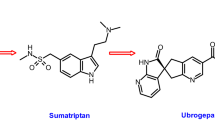Abstract
Migraine is a paroxysmal disorder characterized by attacks of headache, nausea, vomiting, photophobia, phonophobia, and malaise. This review summarizes new treatment options for therapy of the acute attack. Mild or moderate migraine attacks are treated with antiemetics followed by analgesics such as aspirin, paracetamol, nonsteroidal anti-inflammatory drugs, or antiemetics combined with ergotamine or dihydroergotamine. Sumatriptan, a specific serotonin (5-HT)1B/D agonist is used when attacks do not respond to ergotamine, or when intolerable side effects occur. The new migraine drugs zolmitriptan, naratriptan, rizatriptan, and eletriptan differ slightly in their pharmacological profiles, which translates into minor differences in efficacy, headache recurrence, and side effects. New drugs in migraine prophylaxis include cyclandelate, valproic acid and magnesium.
Similar content being viewed by others
Author information
Authors and Affiliations
Additional information
Received: 30 August 1998 Accepted: 10 October 1998
Rights and permissions
About this article
Cite this article
Diener, H., Kaube, H. & Limmroth, V. Antimigraine drugs. J Neurol 246, 515–519 (1999). https://doi.org/10.1007/s004150050396
Issue Date:
DOI: https://doi.org/10.1007/s004150050396




